|
|
|
|
|
|
|
Fond. Gottfried Matthaes
|
||||
|
Determining the
authenticity of |
|
|
|
|
|
|
|
Fond. Gottfried Matthaes
|
||||
|
Determining the
authenticity of |
|
Information about the authenticity of
ancient
paintings
|
|
|
A work of art
Once finished, it
acquires
(M. Hours |
|
|
"Giuditta
I" |
A recent copy of |
|
Example of certificate
made by the scientific laboratory of the Museum |
The Scientific Laboratory of
|
|
 |
|
|
Results of the
scientific tests performed on
the painting |
|
|
The above tests allowed to state the compatibility of the material, signs of ageing and techniques with the period of the painter’s activity.
|
|
|
The scientific laboratory of the Museum
Every attempt to determine the authenticity of a painting must begin
with tests and analyses to establish whether the age of the painting
and the
materials and techniques used are compatible with the presumed date
of execution. The objective elements attesting to the authenticity of a work
are to be found in a scientific laboratory! |
||
|
The Museum laboratory’s mission is to improve existing scientific methods and
elaborate new methods for the ascertainment of the authenticity of art objects.
The laboratory’s instruments and know-how for the determining of authenticity are
at the disposal of collectors, art experts, restorers, art galleries and
museums.
(The staff of the laboratory, who speaks
the main European languages, is at your disposal for any explanations). |
|
Tests carried out by the
laboratory:
 |
 |
 |
|
Spectroscopic dating and characterization of wooden objects |
Microscopic tests on paintings |
|
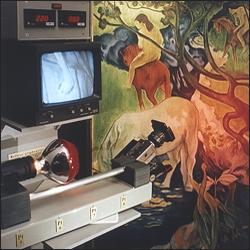 |
 |
 |
|
Examination of underlying layers using infrared reflectography |
Analyses of paint layers with a duroflexometer |
Analyses with Wood’s light, UV and IR |
|
FURTHER ANALYSES PERFORMED IN THE LABORATORY: Spectroscopic chemical analyses on pigments, glues, encrustations, patinas, products of corrosion. Scientific, practical and instrumental tests of authenticity on: ivory, amber, archaeological glass, pigments, metals, stones, carpets, tapestry, prints, books, clocks and watches, china. |
|
||||
 |
The value of
expertise on art |
 |
|
|
||
|
|
|
|
|
In the past, when called on to appraise and attribute a painting, art experts examined only the surface under natural light. A superficial examination of this kind was sufficient, however, because it was artistic style and technique they were looking at. This way of examining a painting has remained the same to the present day, but the attention is now focused almost exclusively on the painter’s signature. The fact that today, as in the future, it is often impossible to attribute a work to an author with certainty, induces the thought that current art appraisal methods are all to the advantage of the market. Whilst this type of ascertainment is to the dealers’ advantage, for buyers it could mean the almost total loss of their investment if one day this overemphasis on the signature were considered illogical and mistaken and a more traditional way of attributing art returned to favor. Today it is already possible to reduce this risk thanks to the dating and scientific analyses of the various component materials of the painting and its support. Any incompatibility between the measured ages and information on the presumed author reveals to the owner, before he seeks an expert opinion, that he has acquired one of the myriad recent copies in circulation.
Get further and detailed information
from our web site: |
||
|
Example of the complete certificate |
The Scientific Laboratory of
|
|
|
|
The painting has been studied with microscopic, IR reflectrographic, Wood’s light and FT-IR spectroscopic analyses, to verify its compatibility with the presumed period. |
|
|
Painting
on canvas (49 x 60cm) |
||
|
|
||
 |
 |
|||
 |
||||
| Photo 2 |
Photo 3 - |
|||
|
Having thus
ascertained that at least the two side strips of the stretcher
are unquestionably original and coeval with this painting, we
proceeded to date them scientifically. The spectroscopic
analysis of the wood gave the following results: |
|
Wood type = conifer |
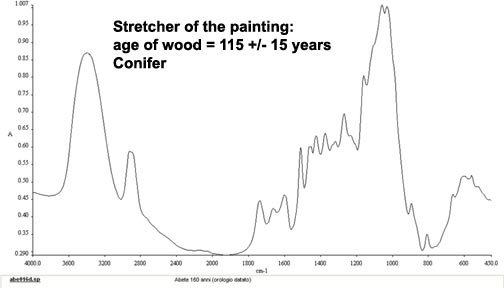 |
|
|
Age of the
wood = 115 +/- 10 years |
Analysis of the Painting layer |
||
|
Many areas of the painting evidence a deep,
extensive craquelure. The development of the same is also logical:
it varies according to the different colours and in particular is
more marked in the light-coloured areas which, containing less
binder, are also less elastic and the first to develop cracks (macro
photos no.5
and no.6). |
||
|
|
|
|
|
Photo 5 - deeper craquelure in the light-coloured areas |
Photo 6 - craquelure variation according to the different colours |
|
|
|
||
|
|
||
|
The microscopic
examination of the signature (macro photos no.7, and no.8)
evidenced its uniformity with the rest of the painting: it can be
seen, in fact, that the colour has worn to the same degree,
especially in the more protruding areas, and has not penetrated into
the fissures of the craquelure as would have been the case if the
signature had been inscribed onto a painted surface that was already
old. |
||
|
|
|
|
|
Photo 7 |
Photo 8 |
|
|
Examination under Wood’s light also showed that the reactions of the signature were comparable to those of the rest of the painting (photo no.9 taken under Wood’s light). These observations therefore attest to the fact that the signature is contemporary with the painting. |
|
|
Total analysis with Wood's light |
|
|
|
An overall
examination of the painting under Wood’s light showed up a
little number of restored areas, particularly to the upper
right in correspondence with the sky: in fact under Wood’s
light these areas appear as dark patches. They are clearly
visible in photo no. 10 taken with the help of specific
filters and subsequent digital elaboration. |
|
IR Reflectographic
Analysis |
||
|
The analysis in
infrared reflectography allows to study the painting in
depth obtaining information about possible drawings
below the painting surface. |
||
|
Foto 11
-
In this specific
case the analysis did not found a preparatory drawing of the
subject below, but it pointed out some parallel lines to
external edges, which determine a perimetric rectangle. |
 |
|
|
|
|
An FT-IR spectroscopic test was then carried out on a number of areas of colour in order to establish the pigments used.
In particular we
studied a surface white, the white preparatory layer and the blue of
the river water.
|
|
The white used on the surface resulted as being
made up of: lead white with barium sulphate and an addition of zinc
white; The absence of titanium white, a pigment used only after 1920, was also verified. |
 |
 |
 |
||||
|
|
||||||
|
Conclusions: The above observations and the results of the scientific tests give us a series of positive indications of the painting’s natural ageing:
-
the result of the age of the stretcher: 115 years For these reasons it is possible to attest its compatibility with the spectroscopic dating of the wood of the stretcher. It is also positive that there are no signs of forgery in the painting or in the signature itself and that its apparent age coincides with the last years of life of the painter in question. |
END OF THE CERTIFICATE
To return to the
laboratory: click
|
The following pages propose
|
|
A) - Tests which the owner can carry out in his own home, following the instructions set out here or in the Museum's Handbook. B) - Scientific tests carried out in the laboratory on samples taken by the owner and mailed to the Museum. C) - Tests which can be performed only in the laboratory by bringing the object along. (See the first pages)
The examples shown here have been chosen by the laboratory of the Museum of Art and Science to advise or inform the owners of paintings of the numerous possibilities in existence, enabling them to better assess the value of their artefacts.
There are no descriptions of stylistic features,
the formal aspects of which have already been treated by an abundance of
art books in all languages. These books are, however, attentively read also by
forgers who, wanting for instance to specialize in Gothic painting,
can not
only document themselves on techniques and styles of the period, but gain even
more information than an artist or craftsman living at that time on the
materials used and on the overall cultural context.
The texts and photos of this website are
extracts from "The Art Collector's Handbook"
|
A) TESTS WHICH CAN BE PERFORMED AT HOME
Visual tests with the aid of a magnifying glass
(1:10).
The three most significant examples have been chosen from among the
numerous available.
1 -
Craquelure
One of the most reliable clues to distinguishing old from new is offered by the
network of cracks that develops over time in the paint layer (craquelure).
This is caused almost exclusively by deformations in the painting's wooden or
canvas support.
 |
The canvas of a painting easily |
 |
In oil paintings cracks usually form |
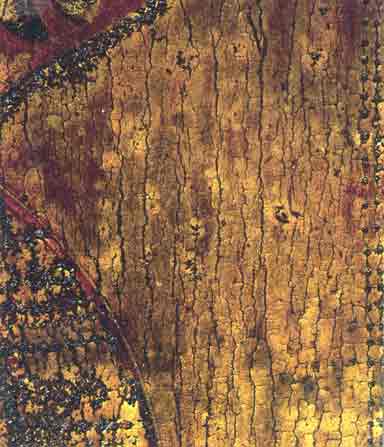 |
panel
paintings |
2 - Pigments
Most of the pigments used until the start of the 19th century were obtained
from minerals, natural metal oxides, earths of various colours and a
small number of vegetable colourants.
 |
The size of the grains of pigments |
 |
Since a colour's hiding power increases, |
 |
Many yellow pigments are |
3 - Patinas and protective varnishes
 |
The outer layer of paint in |
 |
 |
|
If the same test is carried out on a recent copy, fresh and industrial colours re-emerge. The alcohol test, preferably performed by a restorer, causes no damage. |
The most
commonly-used method |
B)
scientific
examinations on samples of material taken by the owner and analysed by a
laboratory.
|
. |
Determination of the type of material and distinction between natural and synthetic. |
|
. |
Comparison between the age of the material present in the painting and the date of introduction and utilization of the same in painting. |
|
. |
Absolute dating of the wood used as support or stretcher. |
Modern technology,
applied by experts, allows the certain distinction between an antique
painting and a relatively recent copy of the same, but does not permit
an original antique painting to be distinguished from a copy of the same age.
In order to know the name of the artist it is necessary to have the
historical documentation of the painting appraised by a serious expert.
Instructions on how to take samples of material
|
|
|
||
| I
|
Panel paintings:
gather a few mg of wood dust both from the surface and in depth from
the rear of the panel, following the instructions provided in our
website
www.spectroscopyforart.com. The sample taken from the surface
permits exclusion of the use of wood that was already old. The
results of the analysis establish the age of the wood with certainty. |
II |
Pigments, binders in general and canvas: Remove a piece of canvas of the size of about 1 cm² bearing remains of paint (see drawing). |
| III |
Specific pigments (whites,
blues,
yellows and greens): |
The results of tests II and III give the verdict: “compatible” or “incompatible” with the presumed age
C) specific tests carried out by the laboratory of the museum of art and science
Thanks to the laboratory's modern equipment, a painting can be subjected to
analysis using infrared reflectography, Wood's light, a
stereoscopic microscope, IR spectroscopy and other instrumental
techniques.
|
|
|
Microscopic analysis |
|
examination of craquelure |
analysis of pigments |
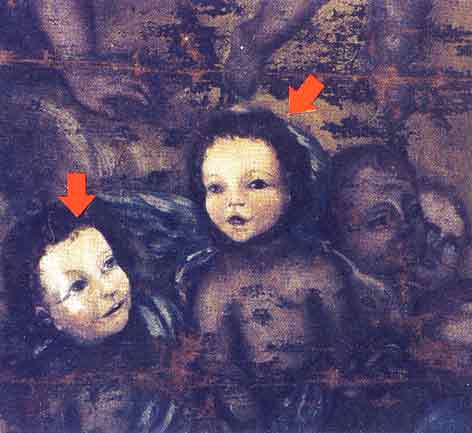 |
|
Wood's light and monochromatic lights permit an evaluation of the extent to which the painting has been restored, touched up and overpainted, as well as the identification of various fluorescent substances. |
|
restoration work shown up |
stucco work identified |
 |
|
Infrared reflectography permits an in-depth examination of the painting bringing to light underdrawings or grids, pentimenti, and the depth of the craquelure, and identification of restoration work or the use of different materials. |
|
depth of craquelure |
underlying grid |
|
|
|
IR spectroscopic analysis permits the analysis of various materials to ascertain their compatibility with the presumed historic period: pigments, binders, glues and varnishes. Minimal sample quantities needed. |
|
|
sample to be analysed enclosed in a KBr pellet |
insertion of sample in the spectrophotometer |
 |
|
IR
spectroscopic
|
|
|
spectroscopic analysis unit |
dating spectrum |
 |
|
Evaluation of the |
|
|
analysis with duroflexometer |
measurement of surface elasticity |
The laboratory also digitalizes images obtained by the various techniques,
carries out examinations under reflected and raking light, and performs
microchemical analyses.
Certificates are issued with a clear and exhaustive report on the results of
the analyses.
Graphic Art and Prints
Sheets of paper coloured by mechanized systems for mass
production are hard to define as works of art.
Furthermore, in the case of signed items sold at relatively high prices, the
risk that they are not authentic is also very high.
|
Let us take for example the most widely sold and esteemed graphic artist: Salvador Dalì. The attempt to ascertain the authenticity of a print is fruitless. |
|
|
Dalì |
Icons
|
Icons were painted in cloisters by nuns and monks as a testimony to their faith and devotion. The icon painter tries to impart a transcendent spirit to the painting by praying at length and fasting as he creates the image. To reach this objective the faces are painted in different layers of colour, each coat of which is left to dry before the next is added, thus leaving the artist-monk long intervals to spend in prayer. The main clue to distinguishing authentic icons from faked ones at first sight is the stratification of the paint on the faces, which appear almost in relief if observed under a raking light (see Collector's Handbook pp. 65-76) |
|
For all other investigations, what has been said for panel paintings holds good also for icons.
|
|
The Founders and the staff
|
|
||||||||
 |
 |
||||||||
|
Gottfried
Matthaes |
Giovanna
Cozzi Matthaes |
||||||||
 |
 |
 |
 |
||||||
|
Dott. Chim.
Peter
Matthaes |
Patrizia
Matthaes Administration |
Silvia Mayer Language and Communication |
Dr. Martin Matthaes | ||||||
 |
 |
 |
 |
||||||
|
Chiara
Civardi First lab assistant |
Roberta
Delmoro Art Historian (Freelance) |
Marta
Cugnasca Data processing |
Sonia
Checchini Conservation |
||||||
NOW OPERATIVE !
Branch of the Milan scientific laboratory
for determining the authenticity
of valuable antique art objects
|
Other requests may be sent, as always, directly to the Milan laboratory at the following address: Museo d’Arte e Scienza |
 |
|
For further info: |
www.Museoartescienza.com
www.AntiqueFurnitureAuthenticity.com |
|
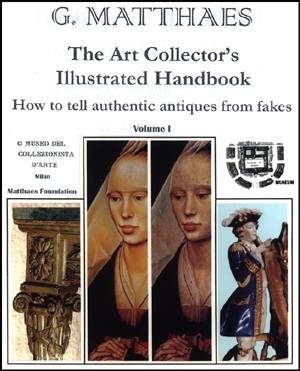 |
|
||||
| Title: | THE ART COLLECTOR'S ILLUSTRATED HANDBOOK (three volumes - three languages) |
|
The Author, Gottfried Matthaes, a physicist, was born in Germany of a family of longstanding artistic tradition and since 1960 has dedicated himself to the study of practical and scientific methods for the ascertainment of authenticity. In 1990 he founded the "Museo d'Arte e Scienza", the only one of its kind in the world, in the centre of Milan where most of the objects illustrated in the handbooks are exhibited, together with its attached laboratory. In 1993 he discovered and patented the application of IR spectroscopy for the age dating of wooden art objects. |
|||||||||
| Contents: |
|
||||||||
| Price: |
Volume 1 (278 pages)
40.00 Euro Volume 2 (128 pages) 30.00 Euro Volume 3 (128 pages) 30.00 Euro Shipping charges are not included . |
International Code: |
Volume 1 - 1997, Code ISBN
978-88-900454-5-5 |
||||||
| How to buy it: |
|
||||||||
Examples of pages
taken from volume 1
|
|
|
OTHER SITES OF THE MUSEUM OF ART AND SCIENCE:
www.MuseoArteScienza.com - Sections of the "Museo d'Arte e Scienza": 6 rooms dedicated to the ascertainment of authenticity in art and antiques, 5 rooms about The "Treatise on Painting" of Leonardo Da Vinci and Leonardo's activities in Milan, 5 rooms dedicated to African Art and Buddhist Art, 2 Scientific Laboratories.
www.LeonardoDaVinciMilano.com - two permanent exhibitions: "Leonardo Citizen of Milan" and "Appreciating Art through the Eyes of Leonardo" from his "Treatise on Painting".
www.AuthenticAfricanBronzesandCeramics.com - dedicated to the authenticity of African artworks in bronze, stone and pottery. The scientific laboratory of the Museo d’Arte e Scienza has developed valid methods for telling authentic African objects from copies and fakes.
www.ArtAndScienceHandbook.com - The most complete and scientifically valid guide to ascertaining the authenticity of European and non-European antiques on an objective basis (540 pages and more than 2000 colour illustrations in 3 volumes and 3 languages)
www.AntiqueFurnitureAuthenticity.com - A list of possible
methods for determining the authenticity of furniture based on objective
factors.
www.Excavatedartauthenticity.com - "A list of all the possible ways of determining, on the basis of objective factors, the authenticity of excavated pottery, glass or bronze items from Southern Italy, the Mediterranean Basin, China and South America.".
www.AfricanArtAuthenticity.com - "Art and Life in Black Africa", The African Art didactic section of the Museum (5 rooms and over 350 objects).
www.SpectroscopyforArt.com - Scientific method for the dating of the wood and identification of the wood type used for art objects. Determination of their authenticity through analysis of colours, binders, pigments and other organic substances.
www.Matthaes.org
-
The history of
the G. Matthaes Foundation
from the opening of the painting school
www.CopiesAndFakesInArt.com - Ample further descriptions for ascertaining the authenticity in art for the individual fields of antiques.
www.Ivoryauthenticityandage.com - Ivory, bones and horns can now be spectroscopically dated and recognized with precision.
www.LeonardoTeacherofPaintinginMilan.com - An abridged and illustrated edition of the “Treatise on Painting”.